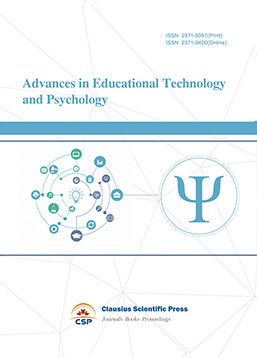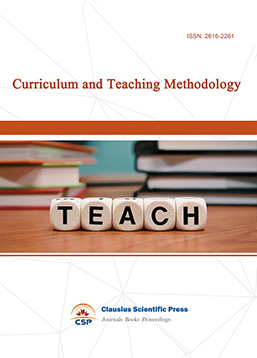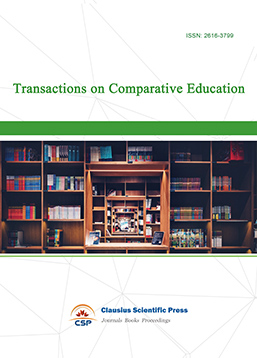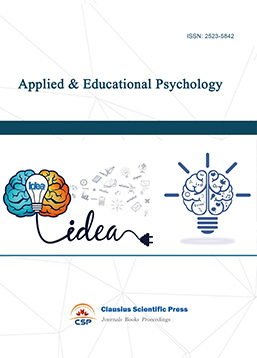Analysis of Collaborative Development Path between Environmental Art Education and Cultural Creative Industry
DOI: 10.23977/avte.2024.060605 | Downloads: 22 | Views: 813
Author(s)
Yue Zhang 1
Affiliation(s)
1 School of Media and Arts, Wuxi University, Wuxi, Jiangsu, China
Corresponding Author
Yue ZhangABSTRACT
Under the background of cultural and creative industrialization, the development of environmental art design education is facing huge opportunities and challenges. Based on environmental art education and cultural and creative industries, this paper analyzed and studied the cultivation of innovative talents in environmental art. Based on the theory of entropy, the coordinated development of environmental art and cultural and creative industries has been discussed. Through a survey of 100 environmental art teachers in 10 universities in Z province, students' interest accounted for 99.00%. Teachers' level accounted for 97.00%, and innovation awareness accounted for 95.00%. These three factors are the top three influencing factors for the cultivation of innovative talents in environmental arts in universities in Z province. At the same time, through a survey of 100 employers, it was found that companies and enterprises' demand for environmental art innovative talents mainly focused on two aspects: professional skills (40.00%) and innovation awareness (31.00%). It can be seen that in the coordinated development process of environmental art education and cultural and creative industries, the cultivation of creative talents is the top priority.
KEYWORDS
Environmental Art Education, Cultural and Creative Industry, Industry University Coordinated Development, Entropy TheoryCITE THIS PAPER
Yue Zhang, Analysis of Collaborative Development Path between Environmental Art Education and Cultural Creative Industry. Advances in Vocational and Technical Education (2024) Vol. 6: 29-38. DOI: http://dx.doi.org/10.23977/avte.2024.060605.
REFERENCES
[1] Marks M, Chandler L, Baldwin C. Environmental art as an innovative medium for environmental education in Biosphere Reserves. Environmental Education Research, 2017, 23(9-10):1307-1321.
[2] Li Y. Teaching innovation of environmental art design specialty based on computer aided. Technical Bulletin, 2017, 55(20):548-555.
[3] Taguchi J. A Case Study Of Built Environment Education Theory In The U.S.: The "Architecture and Children" curriculum and its background. Journal of Environmental Engineering (Transactions of AIJ), 2018, 83(749):625-635.
[4] Sang D P. Policy Discourse Among the Chinese Public on Initiatives for Cultural and Creative Industries: Text Mining Analysis: SAGE Open, 2022, 12(1):45-65.
[5] Shafi A A, Sirayi M, Abisuga-Oyekunle O A. Issues, challenges and contributions of cultural and creative industries (CCIs) in South African economy. Creative Industries Journal, 2020, 13(5):1-17.
[6] Hung T A, Hsu C K, Chen Y C. Constructing a Creative Agricultural Complex Base on the Law for Development of the Cultural and Creative Industries in Taiwan. Open Access Library Journal, 2019, 06(3):1-11.
[7] Liu, Sam C H. Examining social capital, organizational learning and knowledge transfer in cultural and creative industries of practice. Tourism Management, 2018, 64(feb.):258-270.
[8] Jin, Yuanpu. New Forms, Trends and Problems of Cultural and Creative Industries in China Today. Contemporary Social Sciences, 2017, v.2(05):145-161.
[9] Gu X, O'Connor J. Teaching 'tacit knowledge' in cultural and creative industries to international students. Arts and Humanities in Higher Education, 2019, 18(2-3):140-158.
[10] Samuel K C. Neoliberalism, Digital Communication Technologies and the Cultural and Creative Industries. Advanced Journal of Social Science, 2019, 6(1):96-108.
[11] J O’Connor, Gu X, Vickery J. Teaching the cultural and creative industries: An international perspective. Arts and Humanities in Higher Education, 2019, 18(2-3):93-98.
[12] Wang S T, Li M H. Global Search PSO to Analyze the Values of Cultural and Creative Industries. The Open Cybernetics & Systemics Journal, 2017, 11(1):67-84.
[13] Eikhof D R. Analysing decisions on diversity and opportunity in the cultural and creative industries: A new framework. Organization, 2017, 24(3):289-307.
[14] Nevskaya A. Exports of Goods and Services from Cultural and Creative Industries. International Affairs, 2017, 63(3):163-172.
[15] Zhang R, Zhang X. Study on the factors affecting the development of cultural and creative e-commerce industries in henan province. Revista de la Facultad de Ingenieria, 2017, 32(14):283-289.
[16] Yi, Na, Wu, Lingwei. Development and Protection: Reshaping Cultural Policies—A Study of the UN's Advancement of Cultural and Creative Industry in Developing Countries. Contemporary Social Sciences, 2017, v.2(05): 111-123.
| Downloads: | 15442 |
|---|---|
| Visits: | 843076 |

 Download as PDF
Download as PDF



